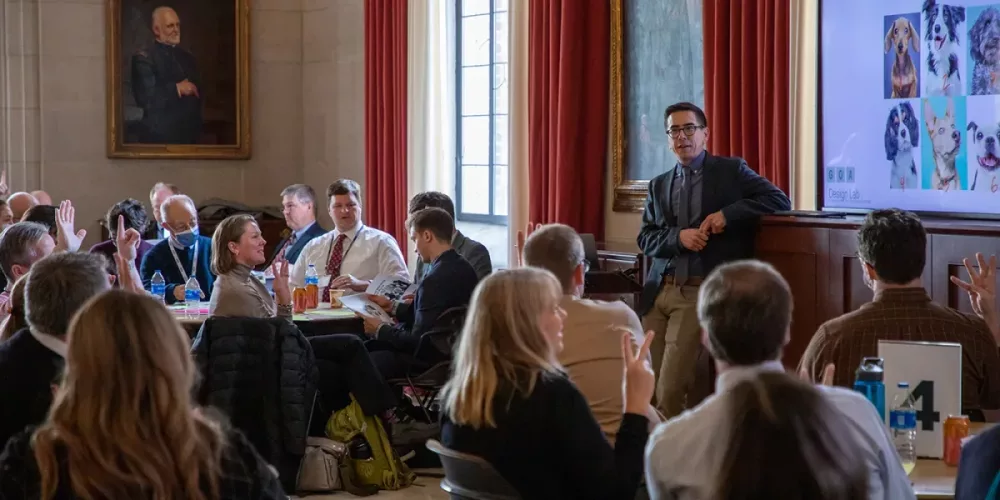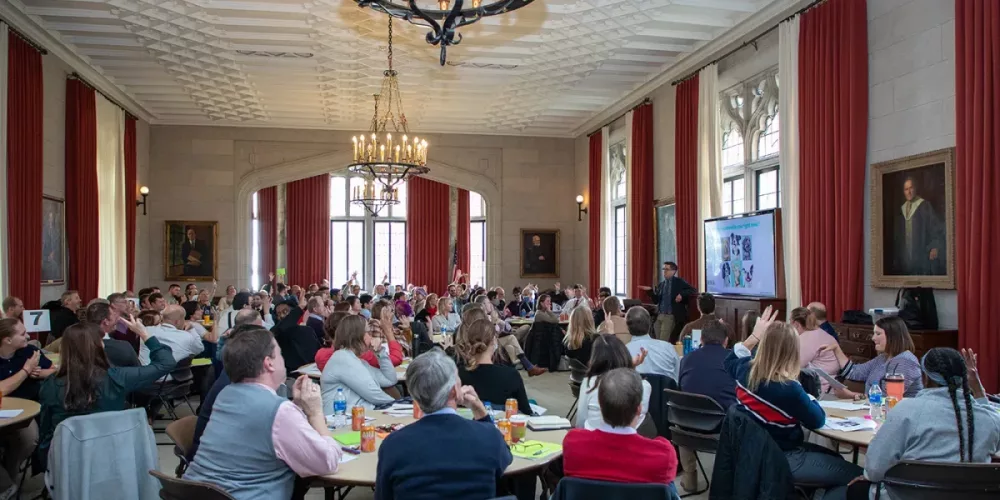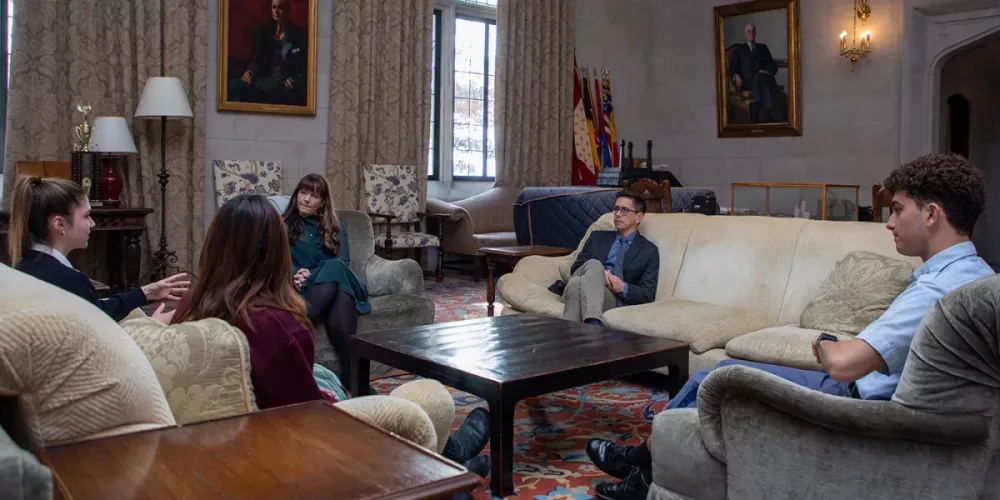Competency-Based Learning at Culver

'IN MEDIAS RES'
This article was originally published on Culver.org on December 29, 2021.
“What is a skill you teach that will matter to your students ten years from now, even if the content is no longer relevant?” The Heritage Room in Legion Memorial hums with conversation from the nearly 140 academic staff and faculty chatting animatedly with their table groups. A careful listener hears snippets of the myriad answers: “inquiry-based approaches to solving real-world problems,” “an appreciation for artistic representations of themes central to the human experience,” “the capability of setting and attaining financial goals through careful budget management,” “the skill of crafting a message — written or spoken — for a specific audience and purpose,” and “strategies for inspiring one’s peers around a community cause.”
The facilitator knows his audience. Most passionate educators can talk at length — and with enthusiasm — about the big educational picture, the personal long-term visions that drive their daily classroom work with young people. Culver Academies educators are no exception. We relish sharing our own vignettes contributing to the ongoing Culver story and — more importantly — interrogating how to revise those vignettes to create an even more powerful draft.
Nov. 10, the date on which these lively conversations unfolded in Legion Memorial, marked the first in-person, full-faculty and academic staff, guest-facilitated professional development workshop Culver has hosted since before the pandemic began. Indeed, the pandemic demanded that many Culver adults invest significant time and creativity to design robust online, in-person, and hybrid experiences. By necessity, community and individual learning over the past several months has focused on adjusting to an unexpected set of challenges. By contrast — and refreshingly — this workshop can be characterized as proactive and progressive rather than reactionary and required.
In March 2021, Culver’s Academic Leadership Team invited Eric Hudson of Global Online Academy to join the group for a virtual workshop on competency-based learning (CBL). Over the 2019-20 and 2020-21 school years, the leadership team contributed to developing a draft of five Distinguishing Characteristics of a Culver graduate: Character, Communication, Leadership, Scholarship, and Well-Being. This ongoing broad school initiative aims to define the distinct qualities of a Culver graduate, articulating how we support our mission to develop responsible global citizens.
Knowing that five teams of talented faculty and staff would be working in 2021-22 to draft a set of competencies more specifically defining each of the current five Distinguishing Characteristics, the team asked questions:
- What is CBL?
- How might a CBL framework help ensure that our students are competent in each of these areas?
- Could a CBL system foster richer, deeper learning experiences for all our students in all of our classes?
The leadership team found both the content and style of Hudson's virtual workshop compelling.

Hudson's CBL workshop was the first full-faculty meeting since the pandemic.
Fast-forward to Nov. 10. Hudson spent the morning meeting with the five competency team facilitators, touring Culver classes with the academic deans, and chatting with Culver students. In the afternoon workshop, Hudson opened by prompting us to “Think about something you’ve learned to do the past year.”
His series of follow-up questions was essential:
- What is this skill?
- How did you learn it?
- How do you know you’ve learned it?
We discovered that answering this series of three questions regarding our students’ learning rests at the heart of CBL. Hudson shared that “CBL is a system that aims to mirror how people learn, work, and succeed in the world.”
Global Online Academy intentionally shifted to a CBL system in 2016, and Hudson echoed a common theme across many educational initiatives — that the work towards CBL at Global will never be “done.” While some sources point as far back as the Morrill Land-Acts of 1862 to identify traces of competency-based education, the term originated in the 1970s. CBL is not a new system. The Aurora Institute (formerly iNACOL), on whose research Global and Hudson draw, originally developed its working definition for CBL in 2011 and recently revised its definition in 2019.
An institution interested in empowering all students to learn deeply and to transfer that learning across diverse contexts must be willing to make five shifts, each of which Hudson introduced and asked us to consider in the context of our Culver practice. A school committed to CBL will shift from content-driven to skill-driven curricular decisions; from time-based to performance-based learning opportunities; from grading to providing feedback on student work; from writing lessons to creating experiences; and from educator-designed to co-designed learning experiences.
As Culver considers how a CBL system might complement the Distinguishing Characteristics work of the five competency writing teams, it’s worth noting that the five shifts Hudson articulated are not completely new to Culver teachers. A shift to CBL would be an evolution — not a revolution. If each shift is a chapter in the ever-evolving Culver narrative, some will require drafting while others will require fine-tuning.

Hudson visited classes and met with students before his workshop.
Hudson’s workshop exit ticket asked us to identify, from among five CBL shifts, a shift of strength and a shift for growth. Most teachers and academic staff ranked one of these three shifts as a strength: the shifts from grading to feedback, from lessons to experiences, and from content to skills. Does this mean all Culver teachers are proficient in each of these shifts? No. Does this mean Culver is fully realizing CBL practices in these three areas? No. But it does suggest Culver is practicing elements of CBL and has a strong basis from which to build into a more fully realized CBL system in future years. Indeed, this would be the work of several years.
Collectively, we ranked the shifts from educator-designed to co-designed and from time-based to performance-based highest in the areas for growth. Time is both highly structured and highly coveted at Culver. In fact, when Hudson asked, “What is one thing you would change about the way time is used and/or thought about at Culver?” the subsequent table conversations included more than a few wry smiles and sighs. Making a shift to a performance-based system would likely require reimagining how time is used at Culver — and that can be hard to imagine.
So, why bother? The Culver story is already well worth the read. Are revisions necessary, and is CBL the mechanism to galvanize change? These questions are worth asking — and answering. The Culver narrative is a compelling one, but even the best writers reconsider their masterpieces. Should this chapter be shortened, expanded, or replaced? Do I need to create a new character here to advance the plot? Is this really the most precise word to describe this scene? We can’t help but ask such questions as we strive to write our own vignettes in the Culver narrative and to empower all students to do the same.
CBL is not likely the only way to foster richer, deeper learning opportunities for students across all learning experiences — but it is one worth exploring. The Culver chapters of previous decades suggest the school is well positioned to continue building towards the shifts Hudson described. A CBL system has the potential to empower Culver educators all across campus to support their students in demonstrating the competencies of each Distinguishing Characteristic.
Hudson’s CBL workshop on Nov. 10 can be considered an early suggestion for revision. In the final moments of the workshop, he challenged us to brainstorm, asking “What is something you’d like to try when it comes to your area for growth?” He encouraged us to consider our spheres of influence and to make a small revision to our practice. Responses like “utilize process portfolios,” “employ a one-point rubric,” “develop flexibly paced units,” and “invite student engagement in project development” illustrate the revision options on several Culver teachers’ minds.
Many of us now share a common language and a burgeoning understanding of a potentially powerful system as we continue brainstorming, writing, revising, and editing. While Hudson’s workshop focused on faculty and academic staff, next steps should invite all the Culver adults in students’ lives to pick up a pencil.
Articulating the competencies that align with our Distinguishing Characteristics has the capacity to honor the many places across campus, both in and out of the classroom, where students are learning, practicing, creating, and mastering. None of us here at Culver are drafting on a blank page or even from the beginning of the story; we are all in medias res, which may complicate — but certainly makes more compelling and rich — the drafting process.
Now, that’s a story worth reading — and writing.
Emily Uebler is Dean of Professional Development and a Humanities instructor at Culver Academies in Indiana.
For more, see:
- Back-to-School Professional Learning: What Educators Need in 2022/2023
- An Introduction to Competency-Based Learning: What, Why, How
- An Introduction to Student Co-Designed Learning

This post is part of our Shifts in Practice series, which features educator voices from GOA’s network and seeks to share practical strategies that create shifts in educator practice. Are you an educator interested in submitting an article for potential publication on our Insights blog? If so, please read Contribute Your Voice to Share Shifts in Practice and follow the directions. We look forward to featuring your voice, insights, and ideas.
GOA serves students, teachers, and leaders and is comprised of member schools from around the world, including independent, international, charter, and public schools. Learn more about Becoming a Member. Our professional learning opportunities are open to any educator or school team. Follow us on LinkedIn and Twitter. To stay up to date on GOA learning opportunities, sign up for our newsletter.
